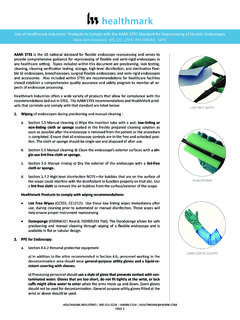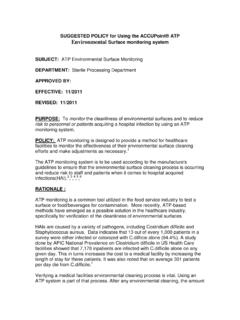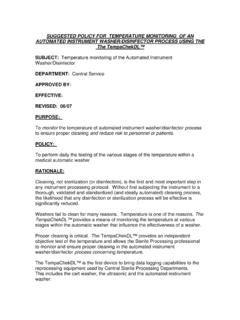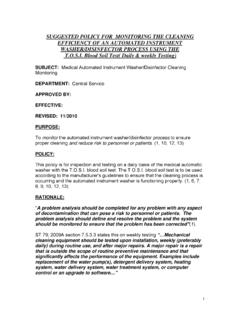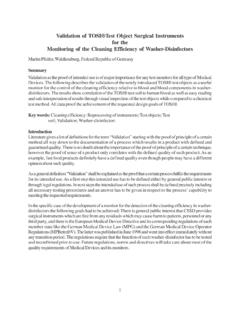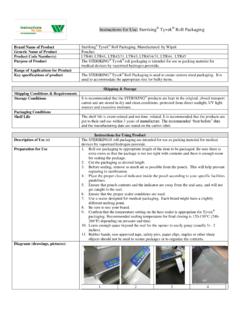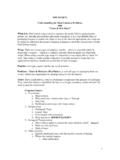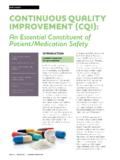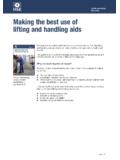Transcription of Improving the Quality of Surgical Trays - …
1 Improving the Quality of Surgical Trays By: Stephen M. Kovach Performance measurement in healthcare represents what is done and how well it is done. The goal is to accurately understand the basis for current performance so that better results can be achieved through focused improvement actions 1. When JCAHO reviews hospitals, Central Service Departments are asked for Quality improvement documentation. Traditionally Central Service Departments (CSD) satisfy this by providing information on their sterilization process. As the Director of Education for a leading infection control products company, I am frequently asked if I have some other types of Quality improvement programs that focus in the area of reprocessing other than sterilization monitoring.
2 One example of this is a Quality Improvement Program (QIP) for the cleaning process2. Recently, I have been asked for a cross-functional program that involves both the Operating Room and the Central Service Departments. As a former Central Service Manager, I still shudder at memories of being called into a room and being shown a dirty instrument or a tray that was missing a key instrument needed right then for a case. All I could say was What can I do for you now to help you complete your surgery. I will follow up on your concern and get back with you once I investigate what happened.
3 My follow-up procedure was in the form of an official incident report as well as a face-to-face meeting with the affected surgeon. Surgical tray errors are considered an incident because they may put the organization at legal risk. The term incident is broadly defined at many institutions as an event that is not consistent with the routine operation of the department. This is why a tray Quality process should be designed to help ensure a safer environment for patients and staff. This process should provide a method to investigate, report and review Surgical tray errors on an ongoing basis.
4 Establishing a Surgical tray Quality improvement program allows an institution to look at the Surgical tray assembly process that is susceptible to error and takes action to install safeguards. Why Monitor Most people ought to be getting the message that there is going to be a requirement that performance be measured and outcomes be measured and we might as well face up to 1We all know that JCAHO wants hospitals to adopt Total Quality Management (TQM) programs. JCAHO is not alone in asking for these such programs. According to AAMI: "A problem analysis should be completed for any problem with any aspect of decontamination that can pose a risk to personnel or patients.
5 The problem analysis should define and resolve the problem and the system should be monitored to ensure that the problem has been corrected. 4 In addition, Central Service groups ASHCSP5 and IAHCSMM6 both support having TQM within Central Service Departments. Implementing a Surgical tray Quality improvement process fits perfectly into any hospital s Infection Control7, or Risk Management TQM program. The Benefits A Surgical tray Quality improvement process will allow a Central Service Department to: Work with their customers one on one and increase customer satisfaction Make the staff part of Improving the Quality of the department Set up realistic goals and standards concerning tray Quality Understand departments process better Improve patient outcomes Reduce costs Improve the Quality of Trays by reducing errors Working with Customers, Creating Satisfaction Implementing a tray Quality improvement process allows you to interact with your customer in a proactive way.
6 By meeting with them they can let you know what Trays they perceive are the trouble Trays for their service. It might be the orthopedic basic tray that seems to be missing a key instrument or a lumen item that never seems to get clean. You then can identify the tray and monitor that tray with the Quality improvement tool. Customer satisfaction should increase because you are working with them on what they perceive as the issue and working towards addressing that concern. Based on my experience, involving the various services and departments, helps tremendously. We had staff physicians talk to the CSD staff on how some of the instruments / Trays were used and how important it was for the CSD staff do their job correctly.
7 2 Make the Staff Part of Improving the Quality of the Department Central Service Department (CSD) staff sees this as a process to help them do a better job along with meeting the various requirements of the accrediting agencies. Monitoring the Surgical tray with a Quality improvement tool allows you to make improvements to the process, which then helps the employee. In most circumstances it is not the employees fault but rather a process that needs adjusting and thus a better understanding of the process is what is needed to solve the concern. Answers to concerns could be as simple: Ensuring each assembly table has proper lighting according to AAMI standards8.
8 Providing a magnifying glass to help with delicate instrument inspection 9. Adding a flushing system for lumen items like a spray gun in the decontamination area10. A Quality improvement process helps with instrument tray changes and the necessary updates to the check sheets and timely in-services. For example, if lumen items were added and they were not being flushed properly, the staff has to be in-serviced again. Using a Quality improvement tool can reveal this. Let the data help you make the changes that are needed. The improvement tool could also show that an employee is having a difficulty with a certain type of tray .
9 Once that is known you can work with that employee and help them assemble that tray correctly. Set up Goals Everybody wants 100% accuracy when it comes to Surgical Trays . You don t want the surgeons and end users to be the primary source of identification for unserviceable Surgical instruments. 11 Using a Quality improvement process helps you reach and maintain that goal. Inevitably, people will make mistakes, but if you are monitoring the process you can catch errors and reduce the incidence of errors associated with Surgical Trays . You can be a step ahead of potential problems if you are monitoring them on a continuous basis.
10 Goals then become measurable and reachable. Patient Outcomes Having a Quality improvement process can only enhance patient care. You will be able to track the source of errors and work towards reducing them. An example would be delays to a case from poor Quality of Trays . If you can decrease your 3error rate (improve) you will have a direct correlation to a patient s care. For example, an Operating Room is waiting for a missing item to be found or sent to them. The delay keeps the patient under anesthesia longer. So solving the concern improves the outcome of the procedure. Many times CSD staff only hears that the delay of a case correlates to lost revenue.
